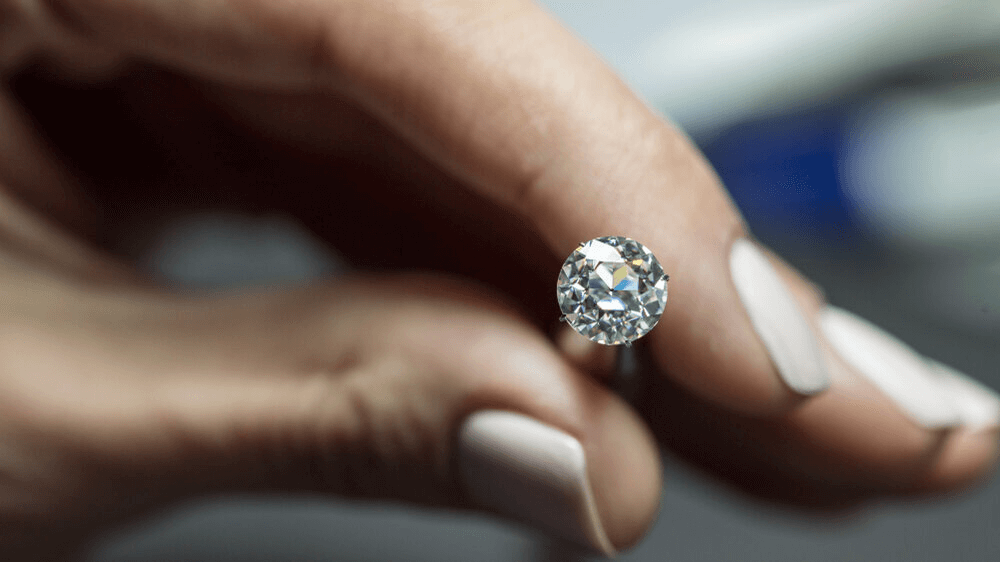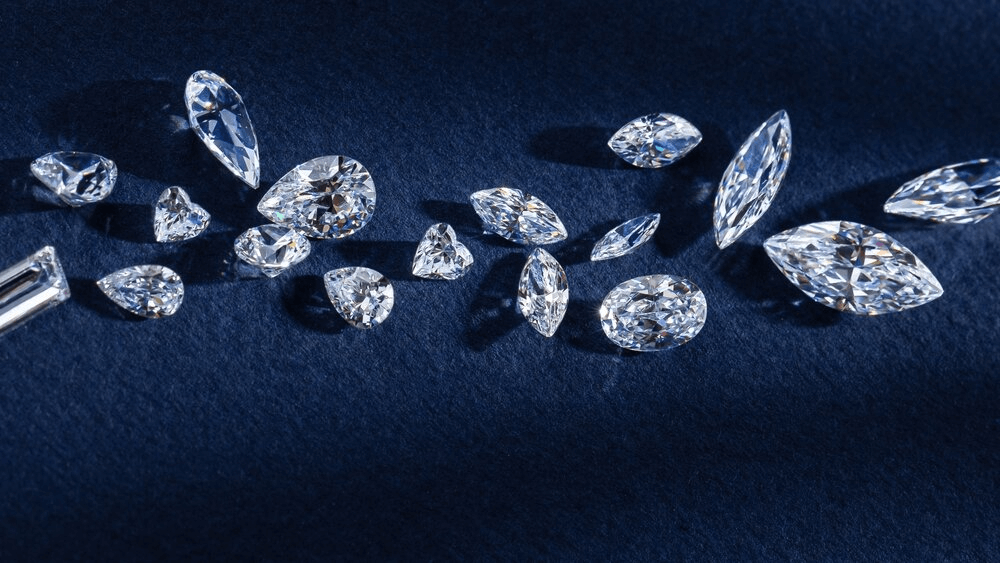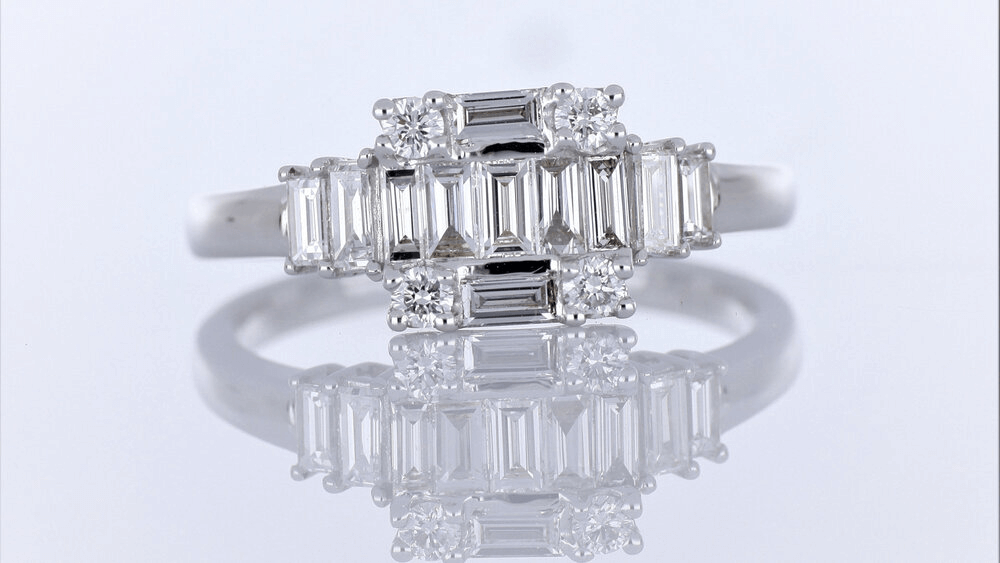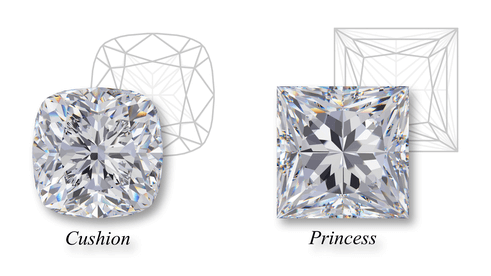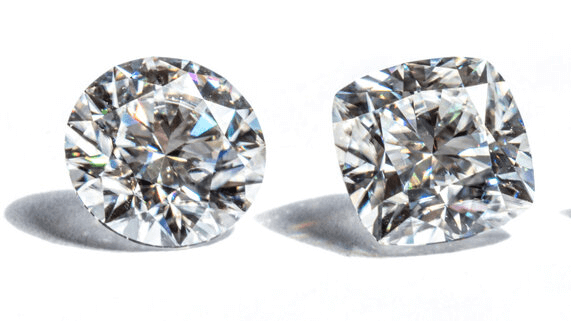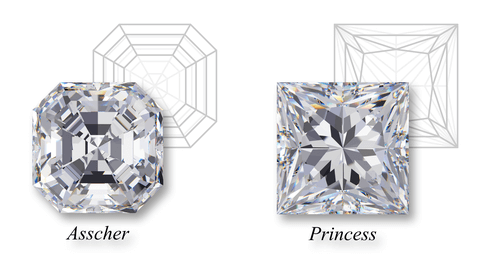Unveiling the Charm: Rose Cut Diamonds vs. Brilliant Cuts

By Gary A.

Edited by Olivia H.
Published Aug 13, 2024
Edited on Dec 18, 2024
When it comes to choosing the perfect engagement ring, the decision between the vintage charm of a rose cut diamond and the dazzling brilliance of modern cuts is as timeless as the gems themselves.

Navigate this guide:
- 8 Quick Tips for Choosing the Perfect Rose Cut Diamond
- Introduction to Diamond Cuts
- History of Rose Cut Diamonds
- The Anatomy of a Rose Cut Diamond
- Comparative Analysis: Rose Cut vs. Brilliant Cut
- Durability and Setting Considerations
- Quality and Cost Considerations
- Our Expert Take
- Frequently Asked Questions about Rose Cut Diamonds
Before we dive deeper into the specifics, here are some practical tips to help guide your decision-making process:
8 Quick Tips for Choosing the Perfect Rose Cut Diamond
Tip 1: Understand the 4 Cs:
Carat:
Refers to the weight of the diamond. Remember, a bigger carat doesn’t always mean a bigger-looking diamond, especially with rose cuts which can appear larger due to their flat base.
Cut:
This determines how well the diamond reflects light. For rose cuts, the focus is on the unique faceting pattern, which gives them their signature soft glow.
Color:
Graded from D (colorless) to Z (yellow tint). Rose cuts can complement a wider range of colors due to their transparency and dome shape.
Clarity:
Refers to the internal and external imperfections. Given the transparency of rose cuts, clarity is especially important as inclusions can be more visible.
Tip 2: Rose Cut Specifics:
Facet Symmetry: Ensure the triangular facets are symmetrical and evenly distributed. This gives the rose cut its distinctive appearance.
Tip 3: Dome Height:
Consider the height of the dome. A higher dome can offer more reflection but might be more prone to chipping. A middle height is often preferred for a balance of reflection and durability.
Tip 4: Transparency:
Due to their flat base, rose cut diamonds can be more transparent. This can affect how color and inclusions appear.
Tip 5: Setting and Durability:
Ensure the setting protects the diamond, especially if it’s a rose cut. Bezel or halo settings are recommended over prong settings for rose cuts to prevent chipping.
Tip 6: Budget and Value:
Rose cut diamonds can often offer a larger appearance for a lower price per carat compared to brilliant cuts. However, ensure you’re not compromising too much on other quality aspects to fit a budget.
Tip 7: Historical and Aesthetic Appeal:
Understand the historical significance and aesthetic of the rose cut. It’s a vintage cut that offers a romantic, soft glow, making it distinct from the more common brilliant cuts.
Tip 8: Certification:
Always ask for a certification from a reputable lab. This ensures the diamond’s quality and authenticity.
Now that you’ve got these practical tips, use Jeweler AI below to find the perfect engagement ring that suits your style and budget:
Introduction to Diamond Cuts
Some things, the olde world just did better. We’re not saying we’d readily embrace their approach to toothbrushing or tunic-wearing, but that, back then, they had a certain something when it came to making beautiful things.
We want to take you all the way back to the early modern period – some time within the 1500s, when the Renaissance was just getting started and, as a result, the world was just starting to get a lot more romantic.
Somewhere among the Davids of Michelangelo and the Vitruvian Men, the rose cut was born – a beautiful, deceptively simple new design for jewelry, and a perfect example of why, sometimes, it pays to understate things…
History of Rose Cut Diamonds
The rose cut is, in many ways, a simple precursor to the Round Brilliant. It’s not a diamond shape you’ll regularly stumble across. Even for experienced jewelers, it remains somewhat elusive…
Origin and Evolution
The rose cut diamond originated in the 1500s, but they didn’t really hit it off until the 1700s, when diamonds were becoming more available. At that point in history, we still hadn’t uncovered the revolutionary Kimberley Mine in South Africa but, even still, diamonds were more commonplace than they had been in the early modern period.
The Georgians and, later, the Victorians took a real shine (pun intended) to the rose cut diamond. Unlike other gemstones, it brought a lot of brilliance and fire to jewelry, and represented the very pinnacle of romance for many.
Keep in mind that, during the rose cut diamond’s heyday, we were still a long way off perfecting the Round Brilliant cut, so the rose cut didn’t have too big of a rival when it came to winning the hearts of jewelry fans.
Our love of the rose cut gradually ebbed away as more and more advanced diamond cuts were created. Tools improved and gemmologists were able to hone their skills, devising shapes like the Cushion and the Oval – modified brilliants that out-shone the rose cut in terms of fire and brilliance.
The Renaissance of Rose Cut Diamonds
Our love of vintage style, simple beauty, and deep symbolism are all responsible for the resurgence of the rose cut diamond. That, and the cut saw fresh interest from notable celebrities like Jennifer Anniston and Lily Collins, whose sparkling engagement rings hit the ‘Gram like a breath of fresh air.
It’s true that the rose cut isn’t as visually impressive as other diamond cuts. We’ll explore why in more detail below. But the rose cut offers something of its own to wearers. It’s a memory from a time gone by, and a U-turn away from the hyper-bright, hyper-colorful shimmer we’re used to seeing in jewelry store windows.

The Anatomy of a Rose Cut Diamond
A rose cut features just 24 facets, which is less than half the number of facets you would expect to see on, say, a Round Brilliant (57).
The silhouette is also simple: a rounded top and a flat bottom. There is no pavilion (the longer, narrower portion of the diamond that ends in a sharp point or small, flat facet known as a culet) and, instead, the diamond’s weight is all held in that upper portion. Instead of a crown and table, there is a small number of triangular facets covering the entire ‘dome’ of the diamond.
Some rose diamonds feature a higher dome, while others are shallower. A higher dome creates more space for smaller facets, which will stop the diamond from appearing overly translucent and give it a more diamond-like appearance. Then again, if you’re a fan of the rose cut, you’re probably a fan of that transparency.
Defining Characteristics
Those triangular facets are what make a rose cut diamond instantly recognizable, even when it’s set within a ring and its silhouette is harder to see clearly. As a result of those larger, three-sided facets, the rose cut diamond is much less ‘showy’ when the light hits. Instead of shimmering with fire and brilliance, it almost appears illuminated – gently flickering it would have done in the light of all those candles back in the Georgian period.
You wouldn’t struggle to distinguish between a rose cut diamond and a round brilliant, despite the fact that they’re both circular when viewed from above.
It is possible these days to track down double roses, which feature the same facet structure on the bottom as they do on the top. This allows for more refraction to take place, producing a more vibrant sparkle.
Facet Symmetry and Its Importance
A proper rose cut will feature triangular facets arranged in a symmetrical pattern across the diamond’s surface. Without that symmetry, light cannot travel through the center of the diamond along the perfect path for creating as much sparkle as possible.
While, these days, nobody chooses a rose cut for its brilliance and fire, it’s understandable that shoppers still want the most sparkly diamond possible.
Comparative Analysis: Rose Cut vs. Brilliant Cut
The Round Brilliant was perfected hundreds of years after the rose cut first entered the scene. Naturally, this means that the Round Brilliant generally appears a lot more sophisticated and refined in terms of its design. After all, it can only be created using a much more advanced understanding of mathematics – and much more advanced tools.
If you feel tempted by a rose cut, it’s important that you understand exactly how – and on what pointers – they differ.
Aesthetic Differences and Performance Under Light
The round brilliant features, on average, 33 more facets than the rose cut. Even if you take sparkle out of the equation for a second, that still equates to a much more intricate, complex, and, some might say, impressive diamond. We’re used to diamonds resembling, well, diamonds – and other, lesser gemstones featuring less impressive cuts.
The rose cut is closer in style to the sort of cuts we see on emeralds and other softer stones. As a result, you may find some people automatically assume that your diamond isn’t in fact a diamond, but something less valuable. Whether or not that matters is down to personal preference.
One thing working in the rose cut diamond’s favor is its size. In a Round Brilliant, a portion of the diamond’s carat weight is distributed in the lower half – the pavilion. A rose cut diamond of the exact same carat weight will appear larger, since all of its weight is distributed across its face-up appearance.
Of course, the round brilliant’s pavilion is a key factor behind its sparkle. If you were to chop off the pavilion, the diamond would be a lot less impressive under a light source, so it’s a case of give and take.
The Verdict
Ultimately, we’re going to have to go with the grain here and say that the round brilliant is by far the better choice for an engagement ring. We’re not saying that the rose cut doesn’t have its own unique charm and appeal – it does. We love the vintage, simple, understated vibes it brings to jewelry. But, when you’re investing so much money and importance into your engagement ring, we’d always recommend you go the extra mile for that wow factor.
Durability and Setting Considerations
Since the rose cut diamond doesn’t feature any sharp corners – or even a culet – it’s quite durable, but that flat base does mean that the edge is a little more vulnerable when it’s exposed to a lot of bumps and knocks.
Protective Settings for Rose Cuts
A halo or bezel is the most protective type of ring setting for any diamond, and the rose cut is no exception. Since the point of the rose cut isn’t to shimmer and sparkle, but to shine, a lot of people aren’t too worried about the light-blocking impact a bezel will have on the stone. Still, if you’re looking to get the biggest possible sparkle out of your rose diamond, avoid any setting that introduces too much metal around the stone.
Any skilled jeweler will be able to design a setting that offers sufficient protection to the rose diamond, without overburdening it with light-blocking design features. Take a look at these range of setting styles for more inspiration.
Quality and Cost Considerations
The same qualities that matter when choosing a diamond with a more popular cut apply when choosing a rose cut. Eye cleanliness is paramount – particularly when you want to maximize the visual appeal of the diamond and overcome that ‘is it a diamond or is it something else?’ vibe that a rose cut can bring with it.
Color is very obvious in a rose cut thanks to those larger, more open facets and the shape’s greater transparency. Stick to the higher end of the Near Colorless range just to be safe.
Cut quality is vital because, without symmetry, the rose cut will really fall flat – even if you love the idea of the shape, an asymmetrical cut will not do the stone justice.
Rose cut diamonds are significantly less expensive than round brilliants, so you’ll get more for your buck in terms of carat weight. This is true of any shape since the round brilliant’s complexity and popularity means that it’s a much more expensive choice.
The rose cut is simple, so that does help shave off some of its value – but, as with anything, while it’s seeing a high point in terms of its popularity, it’s bound to be more expensive.
Our Expert Take
It’s no surprise that rose cut diamonds have re-entered the mainstream. While, yes, they’re technically ‘inferior’ to the cuts we’re more used to seeing – and certainly no match for the brilliance of the round cut – they’re different, and a lot of us really like different.
If you’re falling head over heels for the rose cut, then we really would recommend you take some time to think things through. Yes, it’s different and, yes, it’s elegantly minimalist and oh so romantic – but will it prove just as charming 6 months, a year, ten years down the line?
The Round Brilliant has remained the most popular diamond cut for decades for a very good reason. It’s timeless, not least of all because it makes the very most of a diamond’s innate features. It won’t ever be unseated by passing trends.
Frequently Asked Questions about Rose Cut Diamonds
- Q: What is a Rose Cut Diamond?
- A: A rose cut diamond features a flat base and a domed top with anywhere from 3 to 24 facets, resembling the petals of a rose. This cut is known for its subtle sparkle and vintage charm.
- Q: How does a Rose Cut Diamond differ from a Brilliant Cut?
- A: Rose cut diamonds offer a softer, more subtle glow due to their fewer facets, while brilliant cuts are designed for maximum sparkle and light reflection with their 57 or 58 facets.
- Q: Are Rose Cut Diamonds cheaper than Brilliant Cut Diamonds?
- A: Generally, rose cut diamonds can be less expensive per carat as they often appear larger for their weight and utilize less of the raw diamond during cutting.
- Q: Why are Rose Cut Diamonds popular?
- A: Their unique, vintage appearance and subtle glow appeal to those looking for jewelry with a distinctive, historical look and a romantic allure.
- Q: What settings are best for Rose Cut Diamonds?
- A: Bezel or halo settings are ideal as they provide protection for the diamond’s edges, enhancing the stone’s durability.
- Q: What should I look for when buying a Rose Cut Diamond?
- A: Focus on the symmetry of facets, the height of the dome, clarity, and the diamond’s setting to ensure beauty and durability.
- Q: Can Rose Cut Diamonds appear larger than their actual carat weight?
- A: Yes, due to their flat base and domed top, rose cut diamonds often appear larger when viewed from above compared to brilliant cuts of the same weight.
- Q: Are Rose Cut Diamonds only suitable for vintage-style jewelry?
- A: While they are particularly suited for vintage-inspired designs, rose cut diamonds can be beautifully incorporated into modern jewelry settings as well.
- Q: How should I care for my Rose Cut Diamond jewelry?
- A: Care for it as you would any diamond jewelry: clean gently with a soft brush and mild soap, and avoid harsh impacts to protect the stone’s facets.
- Q: Where can I buy Rose Cut Diamond jewelry?
- A: Rose cut diamonds can be found at jewelers specializing in vintage and antique jewelry, as well as some contemporary designers who incorporate this cut into modern designs.
Discover the Timeless Elegance of Rose Cut Diamonds with Jeweler AI‘s Expert Guidance.
FOLLOW-UP GUIDE SERIES

